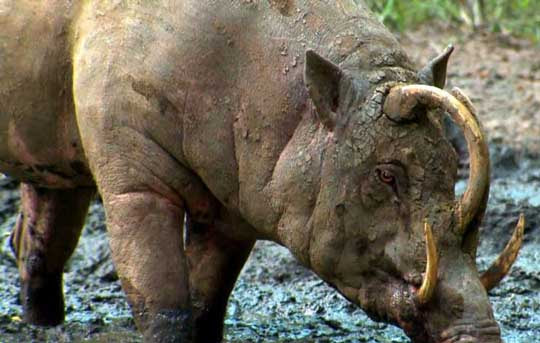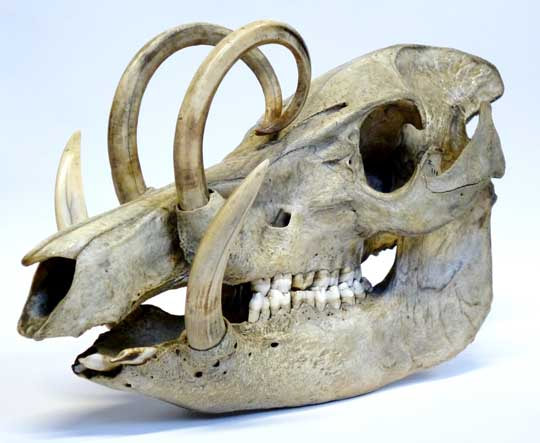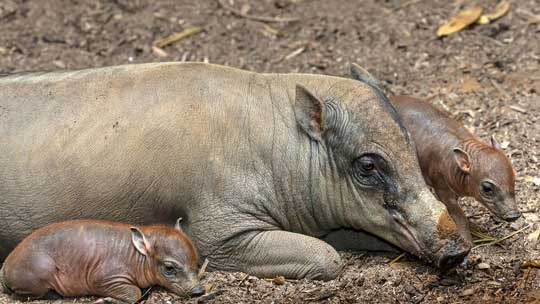|
Sometimes I see a particular animal, and I think, Whoa... that's so weird it's awesome! The Babirusa is just such an animal. It's a pig, but it's very different from all other types of pigs. In fact, it makes me think of some of those long-extinct mammals from prehistoric times. What the heck is a Babirusa? Basically, this creature is a pig, but babirusas branched off from the other groups of pigs long ago. They've been separated from the other pigs for somewhere between 10 and 20 million years! Babirusas grow to about 3.7 feet (1.1 m) long and about 220 pounds (100 kg). The four species of babirusas are found on a few islands in Indonesia, Specifically, the islands of Sulawesi, Togian, Sula, and Buru. Don't those exotic names make you want to go visit these islands? One of the most astounding things about babirusas is their teeth. I'm not kidding—they have some seriously impressive teeth. Or messed-up teeth, depending on how you look at it. Amazing facts about Babirusas Before we talk about the teeth, let's further consider what these creatures really are. As I said above, these creatures are classified in the pig family (Suidae), but they are quite different from other pigs. For example, unlike other pigs, babirusas have complex, two-chambered stomachs, kind of like those of sheep and other ruminant mammals. Also, babirusas do not have the stiff rostral bone in their snouts like other pigs do. So, their snouts are much softer, and they cannot dig with their snouts except in soft mud. Babirusas are also called deer-pigs. It is thought that the people of Sulawesi came up with the name babirusa (in Malay, babi = pig, rusa = deer) because the creature's long tusks reminded them of the antlers of deer. But it is also possible that the name comes from the creature's unusually thin legs (for a pig). Babirusas live in swampy rainforest areas along river banks. They are not picky eaters, and will eat just about anything. They like leaves, fruits, berries, nuts, mushrooms, bark, insects, fish, and small mammals. They are even known to eat smaller babirusas. As I said above, they can't dig with their snouts, but they use their specialized hooves to dig for insect larvae and roots in the ground. Like many pigs, babirusas are fond of mud. The mud helps them keep parasites off their bodies. Okay, let's talk about those crazy teeth, which are long enough that they are often called tusks. Both the males and the females have the lower tusks, which can be pretty impressive. They overlap the edge of the creature's snout as they grow upward (there just isn't room inside the mouth!). Even more impressive, though, are the upper tusks, which only the males have. The first thing to point out is that babirusa teeth never stop growing. As long as the animal is alive, the teeth keep growing larger and longer. The upper tusks start out by growing downward, but then they quickly curve around and start growing upward. Astoundingly, they grow right through the top of the snout. Then these amazing teeth just keep growing. If they don't break off, or if the males do not grind them down against a hard surface, the tusks will curve all the way back and touch the creature's forehead, Although it is rare, sometimes they will even grow right through the skull into the animal's brain. Yikes! The question is, what is the purpose of such extreme teeth? The answer... we don't know for sure. Originally, and understandably, it was thought that the lower tusks were used by males when they would fight for mates, and the upper tusks protected their eyes during these altercations. Sounds reasonable, right? Sure, until you actually observe male babirusas fighting (which they do often). When they fight, they stand up on their hind legs and box, holding their heads high to protect their tusks, which are actually brittle and are not built to withstand much pressure Check out this video about Babirusas and their teeth. So, what are the teeth for? Well, there is a popular story told by locals where babirusas live, which says that the males use them to hang from trees to wait quietly until a female passes by. Umm... I think we can safely rule that idea out as being a whimsical story, right? (although I like the mental image of these creatures hanging around in the rainforest). Probably, the most likely purpose of the teeth is to impress females (kind of like the tail display of a male peacock). The longer the tusks, the more attractive a male is to the females. However, we won't really know this for sure until extensive studies show it to be true. Compared to the bizarre appearance of the males, female babirusas look more like other types of pigs. The babies are just as cute as any pig babies (in my opinion). So, the Babirusa deserves a place in the P.B.A.H.O.F. (Pure Barry Animal Hall of Fame). FUN FACT: The phrase pure barry is distinctly Scottish in origin, used primarily in Edinburgh, and its first recorded use was in 1923. The Scottish National Dictionary defines the term to mean: “fine; smart; used to describe something very good of its type.” Example of use: "That Bridgers 1 book is pure barry, mate. Pure barry, that book." So, pure barry is another way to say awesome! (Thanks to reader Ed Hohmann for telling me about pure barry.) Photo Credits:
Animal tracks - Stan C. Smith Sidewinder tracks - HeyPugshund via Tumblr Fictional woman - https://www.thispersondoesnotexist.com Babirusa #1 - Dunnock_D licensed CC BY-NC 2.0 Babirusa in mud - SmallAnimalPlanet Babirusa skull - UNCL Museums and Collections Female babirusa with piglets - San Diego Zoo
0 Comments
Leave a Reply. |
Stan's Cogitations
Everyone needs a creative outlet. That's why I write. Archives
July 2024
|





 RSS Feed
RSS Feed